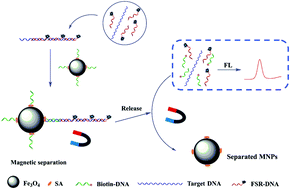A fluorescent method based on magnetic nanoparticles for detection of CGG trinucleotide repeat genes†
Abstract
Fragile X syndrome, which is difficult to treat, has a great correlation with CGG trinucleotide repeats. Detection of the repeat sequence is very important for the early diagnosis of neurodegenerative diseases. In this study, a novel and simple fluorescent method was successfully designed based on nucleic acid modified magnetic nanoparticles (MNPs) and shorter report DNA (FSR-DNA) for the detection of CGG trinucleotide repeats. The FSR-DNA could hybridize multiply with other parts of the target DNA. In the presence of the target DNA, a hybridized complex (biotin-DNA & target DNA & FSR-DNA) was formed on the surface of the magnetic nanoparticles. The target-bound FSR-DNA was then released into the supernatant, which was studied by a fluorescence-based approach. An excellent linear relationship was observed between the fluorescence intensity and the concentration of target DNA in the wide range of 100 pM to 150 nM with a detection limit as low as 84 pM. Moreover, the length of the CGG trinucleotide repeat could be easily discriminated based on this strategy. The strategy exhibited some advantages, including simple operation, excellent selectivity and linearity, and no need for a professional operator. These would provide a very promising option for the early diagnosis of Fragile X syndrome neurodegenerative diseases.



 Please wait while we load your content...
Please wait while we load your content...